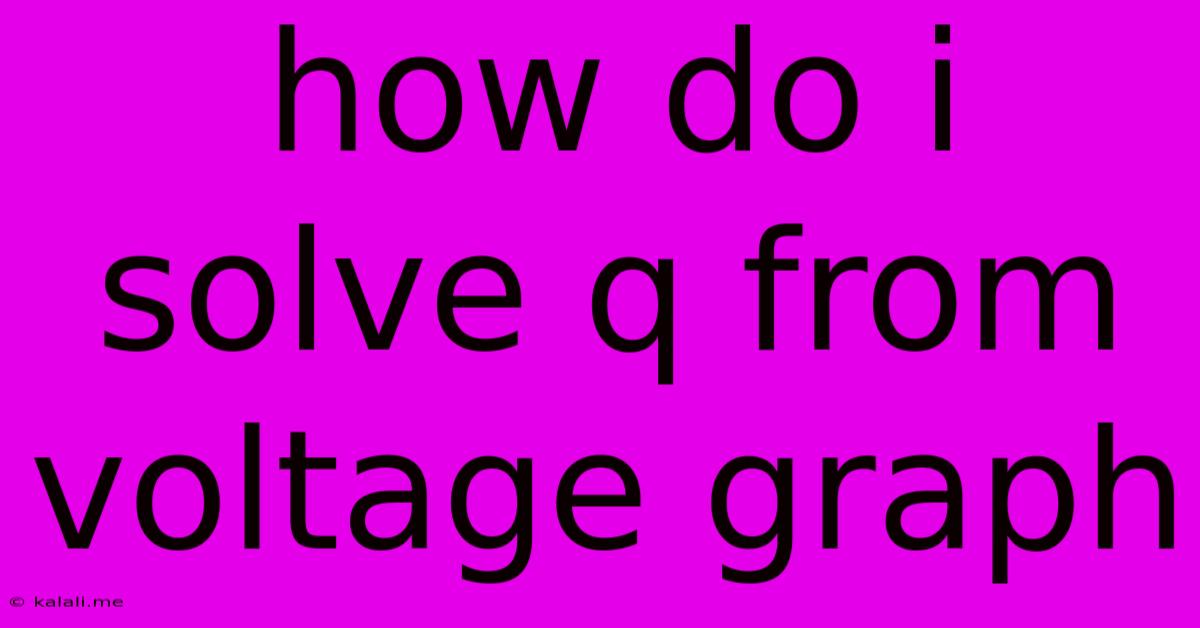How Do I Solve Q From Voltage Graph
Kalali
May 23, 2025 · 3 min read

Table of Contents
How to Solve for Charge (Q) from a Voltage Graph
Determining the charge (Q) from a voltage (V) graph requires understanding the fundamental relationship between these two electrical quantities and the context of the graph. This article will guide you through various scenarios and methods to extract the charge information. The key lies in recognizing the underlying physical principles and applying the appropriate formulas.
Understanding the Relationship Between Voltage and Charge
The core relationship between voltage and charge is defined by capacitance (C), a property of a capacitor which stores electrical energy. The formula is:
Q = CV
Where:
- Q represents the charge (in Coulombs)
- C represents the capacitance (in Farads)
- V represents the voltage (in Volts)
This formula is crucial for solving for Q from a voltage graph, but its application depends on the type of graph presented.
Scenario 1: Capacitor Charging/Discharging Graph (Linear or Exponential)
This is the most common scenario. You'll see a graph where voltage changes over time. To find Q at a specific time:
-
Identify the Capacitance (C): This value is usually given in the problem statement or can be determined from the capacitor's physical characteristics (plate area, separation, dielectric material). If not explicitly stated, you cannot directly calculate Q.
-
Determine the Voltage (V) at the Desired Time: Locate the point on the graph corresponding to the time for which you need to find the charge. Read the voltage value at this point.
-
Apply the Formula: Substitute the values of C and V into the formula Q = CV to calculate the charge Q at that specific time.
Example: A capacitor with a capacitance of 10µF is charging. At t = 2 seconds, the voltage across the capacitor is 5V. What is the charge at t = 2 seconds?
Q = (10 x 10⁻⁶ F) * (5 V) = 50 x 10⁻⁶ C = 50 µC
Scenario 2: Voltage vs. Charge Graph (Linear)
If the graph directly plots voltage (V) against charge (Q), the solution is much simpler.
-
Identify the Point of Interest: Find the point on the graph that corresponds to the specific voltage or charge you want to determine the related value.
-
Read the Corresponding Value: Simply read the charge (Q) value from the y-axis (if the x-axis is voltage) or the voltage (V) value from the x-axis (if the y-axis is charge). This gives you the charge Q directly. No calculation is needed using the capacitance formula.
Scenario 3: Complex Voltage Graphs
For more complex graphs involving multiple capacitors, or situations with non-linear relationships between voltage and charge, you may need to use more advanced techniques:
- Circuit Analysis: Apply circuit analysis techniques to determine the voltage across specific capacitors in a complex circuit.
- Integration: If the relationship between voltage and time is expressed as a function, you might need to use calculus (integration) to find the total charge accumulated over a certain time interval.
- Numerical Methods: For complex, non-analytical functions, numerical methods can be employed to approximate the charge.
Important Considerations:
- Units: Always pay close attention to units. Ensure consistent use of Volts, Farads, and Coulombs.
- Graph Interpretation: Accurately reading values from the graph is crucial. Use a ruler to improve precision.
- Context Matters: The methods used heavily depend on the context provided in the problem or graph.
By carefully considering the type of graph and applying the appropriate techniques, you can effectively solve for charge (Q) from a voltage (V) graph. Remember to always clearly understand the provided information and the underlying physical principles.
Latest Posts
Latest Posts
-
Civicrm 0 Cannot Access Offset Of Type String On String
May 23, 2025
-
An Increasing Function With Zero Derivative Almost Evertwhere
May 23, 2025
-
Android Messenger Spell Check Not Working
May 23, 2025
-
One Second Delay In System Traffic
May 23, 2025
-
1 Foam Board Insulation In Between Block And Stud Wall
May 23, 2025
Related Post
Thank you for visiting our website which covers about How Do I Solve Q From Voltage Graph . We hope the information provided has been useful to you. Feel free to contact us if you have any questions or need further assistance. See you next time and don't miss to bookmark.